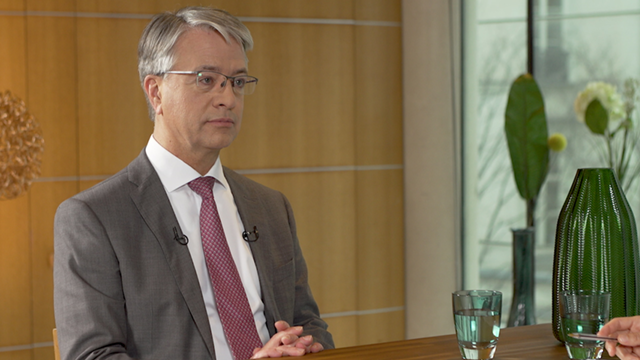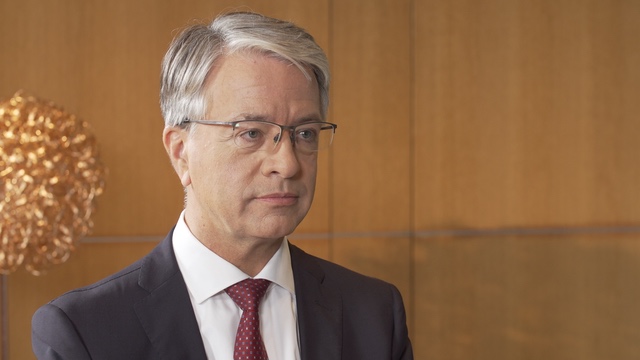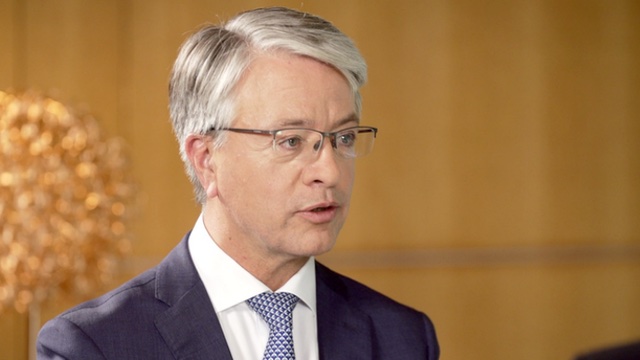EuroBusiness Media (EBM): BNP Paribas, one of the Europe’s largest banks, reports earnings for the first-quarter of 2011. Baudouin Prot, welcome. You are the CEO of BNP Paribas. What are your comments on the Group's performance in the first quarter?
Baudouin Prot (BP): In 1Q11, BNP Paribas confirmed its capacity to consistently generate organic growth.
Group revenues rose to 11.7 billion euros from 11.5 billion euros a year earlier, helped by a sustained level of business activity in all operating divisions. Gross operating income reached 5.0 billion euros due to the containment of operating expenses, despite the introduction of systemic taxes. Thanks to a decline in the Cost of Risk of about one third, net income attributable to equity holders rose to 2.6 billion euros, a 14.6% increase from a year before illustrating BNP Paribas’ strong profit-generation capacity once again.
Consequently, annualised Return on Equity rose to 15.1% from 14.4% in 1Q10 and solvency is at a high level. The Group’s common equity Tier 1 ratio stands at 9.5% at the end of March of 2011, compared with 8.3% a year earlier.
Finally, book value per share stood at 57.7 euros, up 9.1% from a year ago and earnings per share rose to 2.1 euros, up 13.6%.
EBM: Given the ongoing tensions on sovereign debt, and given your exposure to countries such as Portugal, Ireland, and Greece, could you update us on potential losses you could face in the case of a 'haircut' on sovereign debt? Is your Core Tier One level sufficient to withstand such a haircut?
BP: BNP Paribas holds 6.7 billion euros of Greek, Portuguese and Irish government bonds in its banking book, representing 3% of our total Available For Sale asset portfolio.
The purpose of these bonds is to hedge the banking intermediation activities from interest rate risk, therefore we intend to hold them up to maturity.
These bonds are booked in Available for Sale assets, and marked to market through equity. At the end of March 2011, our total AFS portfolio, including these bonds, showed a latent capital gain of 340 million euros.
I do not wish to feed the rumour mill with talk of a haircut scenario on the debt of an Eurozone member country.
Nevertheless, to specifically address your question, a theoretical assumption of a haircut at market prices as at quarter end, would impact the common equity Tier 1 ratio by roughly 15 basis points and the book value per share by approximately 1 euro.
EBM: In the first quarter, your retail networks in your domestic markets (namely France, Italy, Belgium and Luxembourg) were resilient. Nevertheless, isn't there a risk that the European Central Bank's forthcoming interest-rate hikes could jeopardize net interest income generation for your domestic retail banking activities?
BP: France, Italy, Belgium and Luxembourg are sound and wealthy markets, which have continued to show dynamic growth trends in business volumes in the first quarter of 2011.
Outstanding loans in domestic markets grew by 3.9% compared to the first quarter 2010, supported by strong demand for mortgages and a pick-up in corporate loans in Italy. On the deposit side, domestic markets demonstrated an impressive rise in volumes of 8.5% compared to the first quarter of 2010.
Net interest income clearly benefited from this trend.
The ALM of BNP Paribas operates in order to hedge the banking book’s sensitivity from interest rate movements. Therefore, an upward move of 1% of ECB key rates, with long term rates unchanged, i.e. a flattening of the yield curve, would have a negligeable impact on Group revenues.
With a longer term view, the net interest income benefits from high interest rates and a steep yield curve.
EBM: Is there any likelihood that we will see you increase your deposits by enticing customers to switch out of mutual funds into balance sheet funds? If so, is there a risk of seeing the growth of your asset-management revenues decelerate overtime?
BP: In view of the future regulatory environment favouring retail deposits over off balance sheet products, there has indeed been a consistent market trend of outflows from mutual funds into deposits. These transfers primarily involve low-yielding money market funds owned by our French retail banking clients and are revenue neutral for the network.
As for Investment Partners activities, money market funds owned by individuals, represent only a marginal part of the business and are the least profitable. Hence the impact on IP revenues will be very limited.
EBM: You are one of the leaders in Europe in consumer finance through your Personal Finance business. Is the macro economic outlook a source of concern to you in this business line today?
BP: Not really. In the current economic environment and considering our business model and geographic mix, we continue to see room for profitable growth.
This should come from:
_ - revenue growth,
_ -continuing improvement of operating efficiency through the BPCE business alliance
_ -and a positive outlook for cost of risk.
As for revenues, we see 3 levers:
_ - First, in our domestic markets, even though France and Italy will be impacted by tougher regulations, we see upside potential in Belgium. There, we should benefit from an under-developed market and a current lower market share than that of our overall Belgian retail franchise.
_ -Second, Personal Finance is also present in fast growing markets, both directly as is the case in the Czech republic, Hungary and Turkey, and through “PF Inside” which distributes consumer loans through the Group’s networks particularly in Poland and Ukraine.
_ - Lastly, Personal Finance can exploit its know-how in banking partnerships as shown by the successful partnership with Commerzbank in Germany.
EBM: Could you please update us on asset quality trends in retail banking across the board? Do you still expect loan loss provisions in 2011 to be below 2010?
BP: At group level, the cost of risk in the first quarter was down 31% compared to last year. As a percentage of customer loans, it stood at 54 basis points, against 83 in 1Q10 and 72 for the full year 2010. What’s more, non performing loans have started to abate.
These figures confirm the continuing improvement in asset quality across the board, even though the reduction trend differs from one market to another. French and BeLux Retail banking continued to experience low levels of provisions, whilst a stable trend in Italy was confirmed.
Therefore, for the whole year 2011, we indeed expect loan loss provisions to be below 2010. This should be the case particularly for Personal Finance and BancWest. As for Europe Mediterranean, political turmoil in certain countries makes it difficult to predict a trend for the rest of the year.
EBM: In CIB capital markets, which business contributed the most to your strong first quarter revenues?
BP: Capital market activity was very sustained this quarter, in a context of volatile markets increasing clients’ demand for hedging and protection. Revenues reached 2.3 billion euros; 14.5% lower than in 1Q10, which was an exceptional quarter.
In Fixed Income, volume of new issuance was sustained, especially in March, with a great diversity of issuers. In this context, BNP Paribas outperformed the market by increasing its market shares. We confirmed our N°1 spot for all Euro bond issues, with our market share leaping to 8.9% in 1Q11, compared to 8.1% in 2010. We also made significant progress on USD Yankee bond issues, helping us gain 5 places to reach n°4 in the ranking for overall international bonds.
The energy and commodity derivatives activity was also buoyant, driven by demand for hedging from both sides of the industry, producers and distributors alike.
As for Equity and Advisory, both flow and structured products contributed to a good level of activity. Demand for capital guaranteed structured products from retail banking and insurance networks remained strong.
This very good performance was achieved with a further decrease in allocated equity and with a stable value at risk on the quarter, despite increased market volatility.
EBM: In your equity business, parts of your operations are not consolidated in your revenues as they're generated through your JV with Exane. Is it still rational for you to outsource cash equity business while most competitors now integrate cash equity with derivatives and prime brokerage?
BP: BNP Paribas is already a world class player in Equity Derivatives, but we are investing to strengthen the cash equity part of the business. To achieve this goal, it is essential to seek convergence of cash equity businesses, including research and equity derivatives.
To this end, the industrial cooperation between BNP Paribas and EXANE is strengthened and the development plan coordinated. It means combining a strategic view on the developments and a very close and valued relationship in the way we conduct daily business.
The recent coordinated development of EXANE’s Research and BNP Paribas’ reinforcement of the London Investment Banking platform is one major step in that direction in Europe.
EBM: Given the recent improvement in the asset quality of large corporates these past few quarters, should we now expect that the pace of margin recovery in your financing business will subside?
BP: Financing volumes were quite sustained this quarter, contributing to the +6.8% hike in revenues, alongside a very solid level of commissions in Structured Finance businesses.
The asset quality improvement seen in CIB Financing Businesses has contributed significantly to the +20.5% increase in results compared to 1Q10.
Competitive pressure in the market resulted in a moderate decrease in margins. Although there has not yet been a significant impact on margins from capital regulation, it is likely that the industry will go through an adjustment period over the next 12 to 18 months. This is likely to push the weaker players out of some segments of CIB activities and this in turn should help margins recover.
EBM: In your asset gathering activities, notably in asset management, do you still expect net inflows in 2011? Do you still have an appetite for increasing your assets under management through external growth?
BP: Investment Solutions achieved net asset inflows of +8.3 billion euros in 1Q11 with a positive contribution from all businesses. Main contributors were Wealth Management and Insurance.
Asset Management net inflows were driven by new mandates for diversified and bond funds despite continuing outflows from money market funds, albeit at a slower pace.
In general terms, the trend in asset management net inflows for 2011 will depend on several elements, notably interest rate evolution and investor’s risk appetite. In the current environment, money market funds are expected to show further outflows but they may benefit from rising interest rates.
BNP Paribas has reached a significant size with over 900 billion euros of assets under management, of which 456 billion are based in the asset management division after the recent Fortis asset management integration. BNP Paribas now ranks amongst the top players in Europe. Hence, the main focus remains to optimise the current set-up in order to foster organic growth.
EBM: Baudouin Prot, CEO of BNP Paribas, thank you very much!
BP: You’re welcome!






